ORDER
Anseriformes
FAMILY
Anatidae
GENUS & SPECIES
KEY FEATURES
• One of the heaviest flying birds, celebrated for its pure white plumage and effortless elegance
• A notoriously aggressive bird that has the power to inflict serious injuries
Quieter than other swans, but still hisses and snorts loudly when agitated
WHERE IN THE WORLD?
Native of Eurasia; found in populations from Britain to China; introduced to North America, South Africa, Japan, Australia and New Zealand

Lifecycle
Portrayed as a gentle, peaceful creature in fairy tales, the majestic mute swan is actually a temperamental bird that is capable of extreme acts of aggression.
Habitat
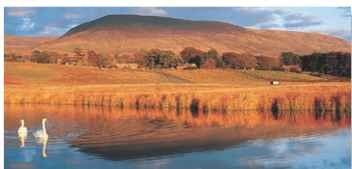
A Swan lake
The mute swan prefers still or slow-flowing water.
Although the elegant mute swan is associated with park lakes and middle reaches of lowland rivers, most populations tend to live in wilder habitats, such as salty estuaries, coastal lagoons and marshes. Wherever it lives, the mute swan requires a plentiful supply of food, in the form of vegetation, and secure nesting sites near or in the water. However, the swan can be found nesting on industrial wastelands along visibly polluted water.
Not all mute swans are migrants, but those in northern regions, such as Scandinavia, tend to fly to temperate zones in the winter
Conservation
A long association with people has made the mute swan tolerant of humans, enabling it to flourish in areas where much of its wild habitat has disappeared. It suffers from disturbance, though; some populations have been hard hit by pollution. Nevertheless, the mute swan is still thriving.
Breeding
Most mute swans pair for life. They mate in spring, when a pair builds a nest together on the water’s edge or in a reedbed. Once eggs are laid, the female incubates them while the male stands guard. However; the male may take over at night while his partner feeds.
Eggs all hatch at once; the downy chicks leave the nest within a day or so to swim with their parents. Although the young can feed themselves, adults use their feet to stir up food particles. At 13 weeks, chicks lose their down and obtain grayish-brown plumage; when the swans are 4-5 months old, they fly By the following spring, most juveniles are independent and live in flocks with other non-breeding swans. Over the next two years the swans begin their search for a mate.
Bringing up babies Both parents care for the young, but usually drive them away after a year.

Music in the air
On a still day the rhythmic throb of the swan’s slow, powerful wing beats can be heard up to half mile away.

Frozen food
Slim pickings in wintersmay force swans south.
Food & feeding
Although the mute swan’s main diet consists of aquatic vegetation, it occasionally extends to insects, fish, frogs and other aquatic life. In estuaries, the mute swan grazes the tender shoots of salt marsh grasses and can be seen cropping the grass in pastures near rivers and lakes. Such food is not particularly nutritious, so the mute swan spends several hours a day feeding.
When feeding in water, the swan seldom dives for its food; it plunges its head and neck below the surface to reach bottom-growing plants. With long neck and legs, the mute swan tends to feed in deeper waters than the ducks and other waterfowl in its habitat; therefore, it does not compete with them for food.
Behavior
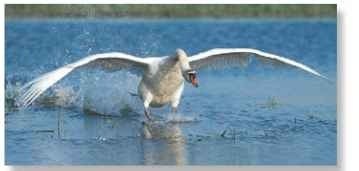
A Cleared for takeoff Swans live on large bodies of water where they make long runs to get airborne.
The mute swan is bad-tempered, especially during breeding season. Each pair defends a small territory around its nest, driving away intruders with hisses and snorts. The male is particularly fierce, charging through the water with his wings raised in an awesome display of aggression. If this fails to deter an intruder, there may be a fight, with both swans beating each other with their wings. Outside the breeding season, in winter, mute swans may gather in large feeding and roosting flocks on open water with adequate food. Even here, violent conflicts between birds may occur.
Among the heaviest of flying birds, the mute swan’s ascent into the air is a lengthy and spectacular show. Once airborne, however, it flies with powerful deliberation, reaching speeds of 48-54-mph. The swan’s beating wings also produce a unique throbbing sound as the air is forced through the feathers.
bodyguard

Brooding…
Incubating her eggs on a nest of sticks and reeds, the female would be vulnerable to intruders if her mate were not ready to defend her.
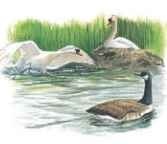
Brave defense…
A Canada goose wandering too close finds itself in trouble as the male swan bursts out of the reeds in all his feathered glory.
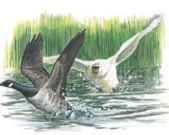
Beating the retreat…
The goose beats a rapid retreat with the swan in close pursuit. The swan’s hooked beak and heavy wings are powerful weapons.
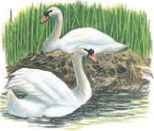
Basking in the glory
The male returns and performs a triumph ceremony — his wings arched over his back and plumage proudly fluffed up.
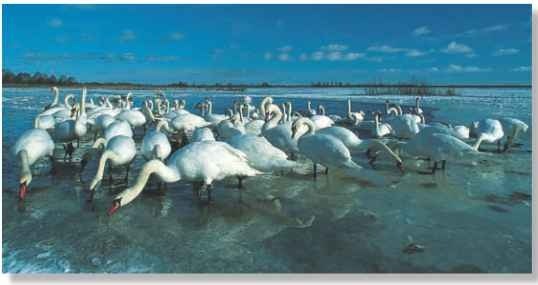
Mute swan’s feathers were once used as quill pens. The shafts would be stripped of their filaments, baked hard in a low oven, then the nib would be cut.
In Britain, all mute swans legally belong to the Queen.
An adult mute swan eats up to 9 lbs. of vegetation a day.
PROFILE
Mute Swan
The pristine plumage and balletic beauty of the mute swan mask its true nature as a bird of enormous weight and power.
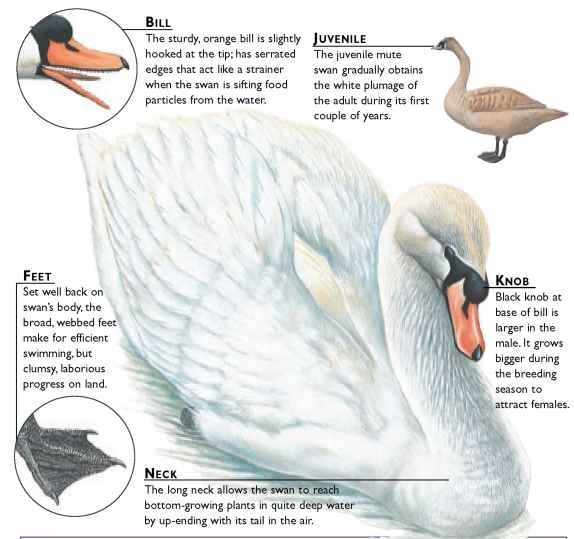
Creature comparisons
Married for its trumpeting call, the whooper swan (Cygnus cygnus) breeds on northern wetlands near the Arctic Circle; migrates south into Europe for the winter Close in size to the mute swan, the whooper swan holds its neck erect like a goose, in contrast to Whooper swan he mute swan’s gentle curve, and has a more wedge-shaped, yellow bill.The whooper swan has similar feeding habits to the mute swan, dabbling for water plants or grazing on wet pastures near rivers and estuaries.The mute swan, the whooper swan has audible wing beats, but the sound is more of a whistle than a throb.
| VITAL STATISTICS Weight 15.5-31 lbs. |
|
| Length | 4-5.5′ |
| Wingspan | 6.5-8′ |
| Sexual Maturity | 3 years |
| Breeding Season | Spring |
| Number of Eggs | 3-12, but usually 5-7 |
| Incubation Period | About 36 days |
| Fledging Period | 120-150 days |
| Breeding Interval | 1 year |
| Typical Diet | Water plants, grasses and small aquatic animals |
| Lifespan | Up to 20 years |
RELATED SPECIES
• Mute swan is 1 of 6 species of swan in genus Cygnus; also includes the trumpeter swan, Cygnus buccinator, of North America, and the black swan, C. atratus (below), of Australia. It belongs to family Anatidae, which contains 147 species of swan, goose and duck.


